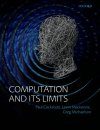By: Paul Cockshott, Lewis M Mackenzie and Gregory Michaelson
264 pages, 17 b/w photos, 69 b/w illustrations
![Computation and its Limits Computation and its Limits]()
Click to have a closer look
About this book
Contents
Customer reviews
Biography
Related titles
About this book
Computation and its Limits is an innovative cross-disciplinary investigation of the relationship between computing and physical reality. It begins by exploring the mystery of why mathematics is so effective in science and seeks to explain this in terms of the modelling of one part of physical reality by another. Going from the origins of counting to the most blue-skies proposals for novel methods of computation, the authors investigate the extent to which the laws of nature and of logic constrain what we can compute. In the process they examine formal computability, the thermodynamics of computation and the promise of quantum computing.
Contents
1: Introduction
2: What is computation?
3: Mechanical computers and their limits
4: Logical limits to computability
5: Heat, information and geometry
6: Quantum computers
7: Beyond the logical limits of computing?
8: Hyper computing proposals
Customer Reviews
Biography
Paul Cockshott was educated at McMaster, Manchester, Heriot Watt and Edinburgh Universities. He trained originally as an economist and continues to be interested in the area. He later studied computer science, obtaining PhD in the same from Edinburgh University. Cockshott has worked in industry for ICL on hardware verification and for Memex on the design of database machines and has been a research worker or lecturer at the universities of Edinburgh, Heriot Watt, Glasgow and Strathclyde. He is currently Reader in Computer Science at the University of Glasgow.
Lewis M Mackenzie is a Senior Lecturer in Computing Science at the University of Glasgow. His research interests are in machine architectures and the performance modelling of communication systems. Dr Mackenzie's recently published work has involved the modelling of traffic patterns in a variety of scenarios from regular wormhole-switched multi-computer interconnects to mobile ad-hoc wireless networks (MANETs).
Greg Michaelson studied Computer Science as an undergraduate at the University of Essex (1970-73) and as a postgraduate at the University of St Andrews (1974-77), working as a real-time programmer at Scottish Gas in between. He subsequently taught Computer Studies at Napier College and Computing Science at the University of Glasgow. He joined Heriot-Watt University in 1983, where he gained his PhD in 1993, was Head of Computer Science from 2003-8 and promoted to Professor in 2006. Dr Michaelson's research interests encompass formally motivated computing, in particular the design, implementation and analysis of programming languages for multi-process systems. He published his first novel in 2008.
By: Paul Cockshott, Lewis M Mackenzie and Gregory Michaelson
264 pages, 17 b/w photos, 69 b/w illustrations
Mathematics, computer science, physics - and even biology - are now beginning to converge. This delightful book, beautifully illustrated, shows the physics of computation and the theory of computation as two sides of the same coin. We are witnessing a paradigm shift, the birth of a fruitful new interdisciplinary point of view.
- Gregory Chaitin, author of "Proving Darwin: Making Biology Mathematical"
"This book provides a unique and important presentation of the factors that have, do and will limit the science of computation. A most stimulating, scholarly and entertaining synthesis of history, logic, mathematics and science." - Stephen Barnett, University of Strathclyde, Glasgow, UK



































